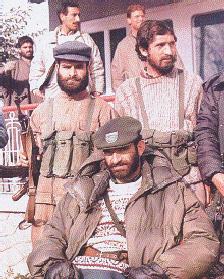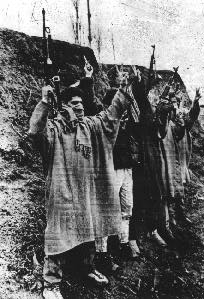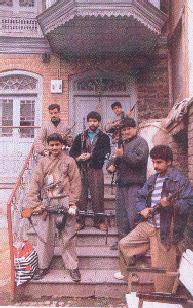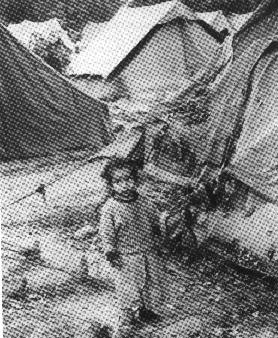Islamic Fundamentalism in Kashmir
Ethnic Cleansing of Kashmiri Pandits
The Muslim and Hindu peoples of Kashmir have lived in relative harmony and friendliness since the 13th century when Islam first became the majority religion in Kashmir. The Sufi-Islamic way of life that ordinary Muslims followed in Kashmir complemented the rishi tradition of Kashmiri Pandits (Hindus), leading to a syncretic culture where Hindus and Muslims revered the same local saints and prayed at the same shrines.Â
 The masked terrorists in Kashmir: Pawns in a bigger game.
The masked terrorists in Kashmir: Pawns in a bigger game.Periodically however, there have been rulers and leaders who have had a narrow view of Islam, and have subjected Hindu minorities to great cruelties and discrimination. The current armed secessionist movement in Kashmir mostly derives its inspiration from these people.Â
 Terrorist leader with bodyguards.
Terrorist leader with bodyguards.A canard is now being spread past few years by the secessionist-terrorists and their sympathizers that in 1990 Kashmiri Pandits left Kashmir willingly, having been "tricked" by then Jammu and Kashmir Governor Jagmohan. Nothing could be farther from the truth. The fact is that Kashmiri Pandits were driven from their homeland after a campaign of intimidation and harassment was launched against them by the military-wing of the secessionists. Kashmiri Pandits were forced from their hearths and homes at the point of gun. The objective of this ethnic cleansing was to create a minority-free Kashmir valley where the goal of Islamization could be easily forced on the ordinary people. The books and articles below will provide you with an in-depth understanding of the genesis of the current political situation in Jammu and Kashmir.
This website aims to tell the story of Kashmir as it was and what has become of it now. Contrary to the misinformation currently being propagated, India did not "annex" Kashmir. At the time of independence in 1947 from British rule and the subsequent partition of the country into theocratic Pakistan and secular India, the Hindu Maharaja of Jammu and Kashmir had the option to join India, Pakistan, or remain independent. He contemplated the latter option, but after Pakistan invaded Kashmir hoping to preempt such a decision, he decided to accede to India. This accession was ratified by Sheikh Mohammed Abdullah, head of the largest political party (the National Conference) representing the Muslim majority of the state. The Sheikh did so because he felt that the interests of Kashmiri Muslims, who practice the secular Sufi-Islamic way of life, would be best served under the protection of the Indian constitution.


The present secessionist drive in Kashmir has its antecedents in the dissatisfaction of a small and insignificant section of Kashmiris (mostly political opponents of the Sheikh). However, since about 1985, this drive has been hijacked by Islamic fundamentalists who have resorted to terrorist tactics, targeting Hindus, Sikhs, and secular Muslims. Since 1990, with training and support from Pakistan, the terrorists are engaged in a low- intensity war against India for establishment of a theocratic nation in Jammu and Kashmir.
To further their cause the secessionists have completed a program of ethnic cleansing, expelling about 350,000 Kashmiri (Pandits) Hindus - something that has unfortunately gone largely unreported in the Western press. These Pandits are at present living as refugees in their own country.
 The refugee camps at Jammu.
The refugee camps at Jammu.
The following pages will show you a glimpse of the history, culture, and the current plight of Kashmiri Pandits. You will understand the goals of the bigoted religious terrorists in Kashmir whose vision of Azadi (independence) is to use religious dogma to exclude women, religious minorities, and secular-minded people from every kind of freedom in social and political life.
Language and Politics in Jammu and Kashmir: Issues and Prespectives
Language is the most powerful means of communication, vehicle of expression of cultural values and aspirations and instrument of conserving culture.
The Hurriyat Role
The Hurriyat is an ISI creation and it does not represent the Kashmiris\' aspirations is ably brought out by O.N. Dhar in his dispassionate study in the light of the historical background.
Slow Eviction of Pandits from Kashmir
At the turn of the century, the population of the Kashmir Valley\'s Pandits was close to a million. Today, no more than a few thousand remain.
Whither Migrants ?
No militancy or terrorism, anywhere in the world, has ever been controlled with appeasement policies or practically financing and aiding the militants by the concerned governments.
Greater Autonomy: To Whom and for Whom
Over a terrifying six years since 1989, the valley continues to simmer with bloody incidents, and Kashmir as such poses many fundamental problems for our polity and the constitution on which it is based.
Threats to India Stability
Dr. Pandit is a renowned columnist, analyst and author. He is a former Director, Centre for Central Asian Studies, University of Kashmir and an eminent Persian scholar.
Impractical Solution
Greater autonomy has also become the catch- phrase of the major regional party of the State, the National Conference (NC).
What to do about Kashmir ?
The most under-reported case of ethnic cleansing worldwide in recent years is undoubtedly the violent expulsion of a quarter million Kashmiri Pandits from Kashmir, practically the whole Hindu population, in 1989-90.
Kashmir: The Problem is Muslim Extremism
What is Kashmir? Is it a piece of orphan territory to be occupied by whosoever carries a gun? Or is it an integral part of an ancient country and the extension of a great culture?
Kashmiriat: Myth and Reality
The word is a Persian derivative from Kashmir and is normally meant to imply the characteristics of a resident of the Kashmir valley.



